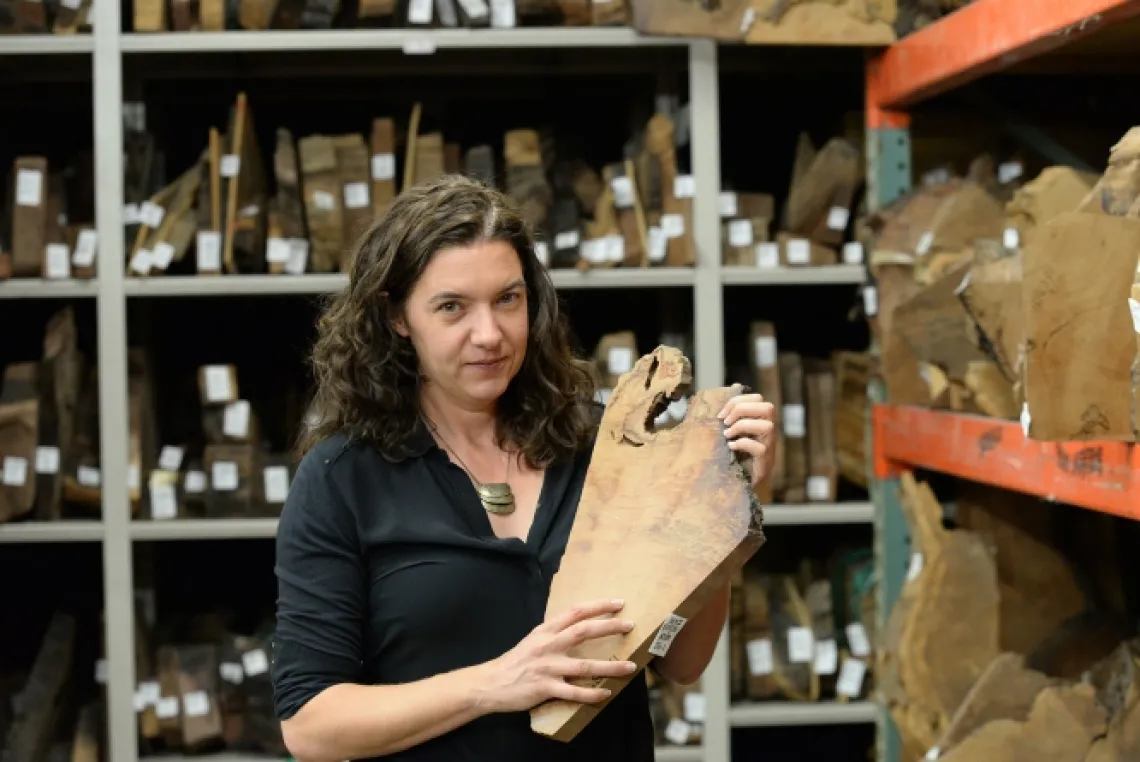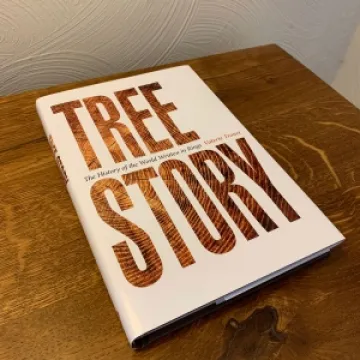Another first for the tree-ring lab
With her recently announced promotion, Valerie Trouet will become the first female faculty member in the Laboratory of Tree-Ring Research to become a full professor

For many, spring symbolizes hope, growth, and change. In academia, where the season brings news of promotions for faculty members, this certainly rings true.
This spring, Valerie Trouet, formerly an associate professor in the more than 80-year-old, internationally esteemed Laboratory of Tree-Ring Research, learned that she will be promoted to full professor this August. Trouet is the first woman in the lab's history to achieve this status. (Connie Woodhouse, a joint faculty member whose primary appointment is in the School of Geography and Development, also is a full professor.)

Trouet's new book discusses how tree rings help scientists study climate and human history.
Trouet is a dendroclimatologist, meaning she studies tree rings to uncover information about past climate. Her primary research focus is climatic variability over the past 2,000 years and its impact on human systems and forest ecosystems. In addition to her research and teaching, Trouet authored the first nonfiction book about tree-ring science for lay audiences, which was published this April, and participates in a peer mentorship program alongside a group of fellow women faculty members on campus. She also is an editor for the peer-reviewed journal Geophysical Research Letters.
Trouet recently spoke about her career journey, the challenges faced by women in STEM fields and the joy of becoming the first woman in the tree-ring lab to become a full professor.
What was your path to the Laboratory of Tree-Ring Research?
I first started working with tree rings for my master's degree in environmental engineering. For my thesis, I analyzed tree rings from trees in Tanzania and was immediately hooked.
Fieldwork is an adventure. We get to travel to beautiful forests and spend whole days there. I also like looking at wood under the microscope. Lab work as a tree-ring scientist is like doing puzzles. You're trying to match patterns, and I really enjoy doing that. And I love how tree-ring research is really at the nexus of ecology, climatology, archaeology and anthropology. We're not just having fun doing the science. We're also contributing valuable information about current and future societal challenges.
After my master's, I went on to do a doctorate in my home country of Belgium. Then I did a postdoctoral fellowship in the United States, then one in Switzerland, and then, in 2011, a position opened up here, so I applied for it and got it.
Was the tree-ring lab on your radar while you were doing your graduate studies?
Yes. Definitely. It's the mother ship. For tree-ring scientists, this is the place to be. The first person to develop tree-ring science, Andrew Douglass, was actually an astronomy professor here at the University of Arizona. So, this is literally where our science originated, and it's the oldest department of its kind worldwide, established in 1937. It's also one of the biggest ones. Everyone in our field is well aware of the Laboratory of Tree-Ring Research at the University of Arizona and it remains a very important, prestigious place for people in our field.
You're the first woman to become a full professor in the tree-ring lab. What do you think that means both for the institution and for you personally?
I've rarely been as happy as this in my life. It's the culmination of so much work and such a struggle, to be honest. I've faced so much insecurity and uncertainty, but, in the end, it all came together. A lot of emotions came to the surface when I got this news.
It's not due to a lack of good women scientists that it has taken this long for a woman to become a full professor in the lab. So, for the institution, I think this is a clear demonstration that things need to change, and that we're taking that seriously. It shows that there is now the opportunity for women to rise to the level of full professor.
During your schooling, did you have any women professors who offered mentorship and made a meaningful impact on your career?
Actually, it's very sad. When looking back on my school years – all the way through my university career – I never had a single woman professor or took a class taught by a woman. So, unfortunately, in my education, I didn't have the opportunity to be mentored by a woman.
Later in my life, some pivotal career moments have been thanks to women who were in leadership positions and enabled me to make big steps forward. For that, I'm very grateful. For instance, I got a National Science Foundation CAREER grant and my program officer was a woman. I am an editor for the flagship journal of my professional society, and I was asked by a woman full professor who knew of my work to take on that role. I just wrote a book about my research field, and the editor at Johns Hopkins University who asked me if I'd like to write this book was a woman. It is critical that there are more women in leadership positions to champion and uplift other women.
Now we have a critical mass of assistant, associate and full professors who are women and can act as a role model for women in STEM and take on leadership roles – but only if given the opportunity.
What unique challenges face women professors in STEM globally?
So much of the sexism, discrimination and inequity we see in STEM is institutional and cannot be addressed solely by the actions of individuals. To protect the safety of, retain and empower women in STEM, particularly women of color, is going to require changes at a higher level. People say, "You women should do more of this, less of that, this is how you function better in a man's world." That has got to stop. It is not because of women that women aren't staying in the field or being put in leadership roles.
Now, I must point out that, thankfully, we're having these conversations at the tree-ring lab on an ongoing basis. This is the state of academia worldwide, and I want to make clear that we're talking about a global issue here. The issue is most critical and urgent for women of color.
How do you plan to leverage your role as the first woman full professor in the tree-ring lab?
I want to provide the opportunities that have been given to me by other women leaders to other women – particularly postdoctoral fellows, women of color and junior faculty. I want to help lift them to where they belong.
At the same time, I became a full professor because I am very good at research and I need to continue that to show that women can do this. As women, we're often pigeonholed as great teachers, but we can also be stellar researchers and I feel an obligation to prove that.
What advice would you give to a woman early in her STEM career?
Participate in peer mentorship. Connecting with a group of women who are going through similar things that you are going through helps you understand what you're experiencing and put it in context.
You have a new book that just hit the shelves. What is it about?
Yes. I've been doing a lot of podcast, radio and newspaper interviews to promote the book, so it feels like all I've been working on lately! It's called "Tree Story: The History of the World Written in Rings," and it's a book about the field of tree-ring research. It's actually the first broad-audience book written on the topic. It talks about how we use tree rings to study climate and human history.
Is there anything else you'd like to add?
I love being a professor. It might be a struggle sometimes, but it's a great job.
And what's so great about being a professor in the Laboratory of Tree-Ring Research is that I don't really need to go anywhere to meet my colleagues, because people in my field, at some point in their career, tend to want to come and visit the laboratory. We constantly have researchers from across the country and the world who come to give talks and collaborate on projects. It's a very dynamic environment, and I feel so fortunate to be here.
Trouet's new book is available on the Johns Hopkins University Press website, as well as through Amazon, Barnes & Noble, Target and independent Tucson bookstore Antigone Books.

